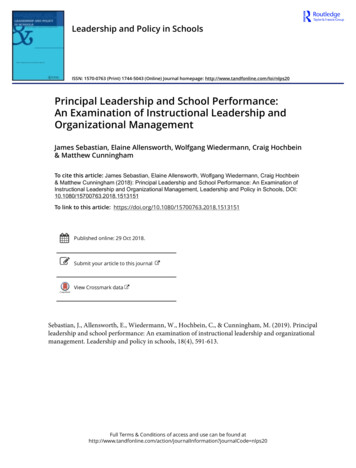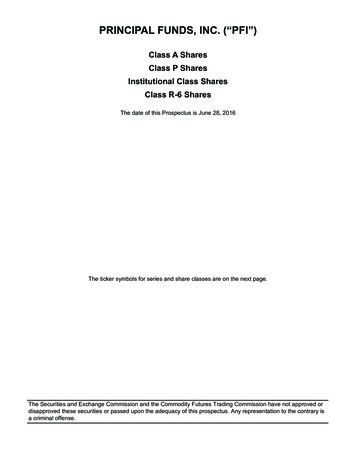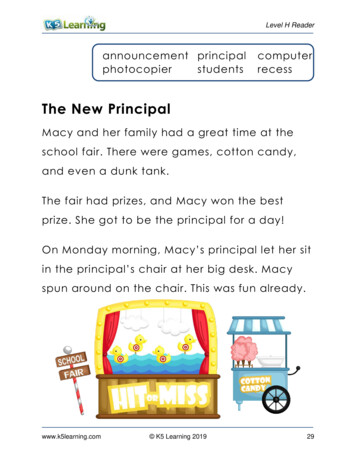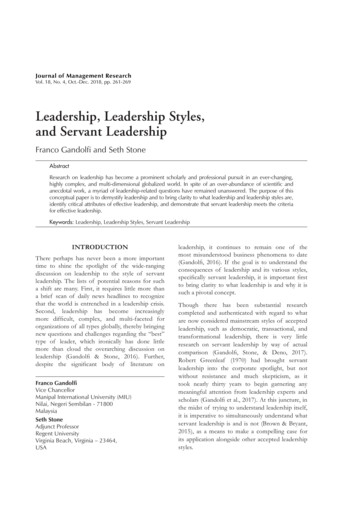
Transcription
Leadership and Policy in SchoolsISSN: 1570-0763 (Print) 1744-5043 (Online) Journal homepage: http://www.tandfonline.com/loi/nlps20Principal Leadership and School Performance:An Examination of Instructional Leadership andOrganizational ManagementJames Sebastian, Elaine Allensworth, Wolfgang Wiedermann, Craig Hochbein& Matthew CunninghamTo cite this article: James Sebastian, Elaine Allensworth, Wolfgang Wiedermann, Craig Hochbein& Matthew Cunningham (2018): Principal Leadership and School Performance: An Examination ofInstructional Leadership and Organizational Management, Leadership and Policy in Schools, DOI:10.1080/15700763.2018.1513151To link to this article: shed online: 29 Oct 2018.Submit your article to this journalView Crossmark dataSebastian, J., Allensworth, E., Wiedermann, W., Hochbein, C., & Cunningham, M. (2019). Principalleadership and school performance: An examination of instructional leadership and organizationalmanagement. Leadership and policy in schools, 18(4), 591-613.Full Terms & Conditions of access and use can be found tion?journalCode nlps20
LEADERSHIP AND POLICY IN 51Principal Leadership and School Performance: An Examination ofInstructional Leadership and Organizational ManagementJames Sebastiana, Elaine Allensworthb, Wolfgang Wiedermannc, Craig Hochbeind,and Matthew CunninghamaaEducational Leadership and Policy Analysis, University of Missouri, Columbia, MO, USA; bUniversity of ChicagoConsortium on Chicago School Research, Chicago, IL, USA; cEducational, School & Counseling Psychology, Universityof Missouri, Columbia, MO, USA; dEducational Leadership, Lehigh University, Bethlehem, PA, USAABSTRACTRecent research work in school leadership highlighting the importance ofprincipals’ organizational management skills has prompted scholars toconsider their importance in relation to instructional leadership skills.However, there is limited empirical work that directly compares theseleadership skills and their importance for school outcomes. In this study,we use principals’ self-ratings to construct typologies of effectiveness inboth domains and compare their relationship to student achievement. Ourresults show that principals view themselves as either strong or weak oninstructional leadership and organizational management skills simultaneously. We also find that learning gains vary significantly across theprincipal profiles.Scholars in general management and business studies have long been interested in differencesbetween leadership and management (Kotter, 1982, 1990, 2006; Zaleznik, 1977). For example,Kotter (1990) noted that “management is about coping with complexity. Leadership, by contrast,is coping with change” (p. 86). Academic debates in business/management research on the distinction between leadership and management are very much alive and likely to continue for the nearfuture (Kotter, 1990; Toor, 2011; Toor & Ofori, 2008). In education research, the central debate hasnot been about management versus leadership but instead on the relative importance of twoleadership styles—instructional and transformational leadership. Instructional leadership includesschool leaders’ work that directly or indirectly supports good instructional practices (Hallinger,2005), whereas transformational leadership emphasizes the role of leaders in motivating and inspiring followers to work for the common good of the organization (Bass, 1985, 1998; Burns, 1978;Leithwood & Jantzi, 1990).In recent years, studies have raised the importance of organizational management for effectiveschool leadership work (Grissom & Loeb, 2011; Grissom, Loeb, & Master, 2013; Horng, Klasik, &Loeb, 2010; Sebastian & Allensworth, 2012; Sebastian, Allensworth, & Stevens, 2014). A study byGrissom and Loeb (2011), in particular, received considerable attention as it directly compared howprincipal perceptions of effectiveness on instructional leadership versus organizational managementwere related to student achievement; they found significant effects only for principals’ effectivenessin organizational management.Researchers have interpreted these findings, emphasizing the importance of organizational management for student achievement as not necessarily incompatible with prior work focusing onCONTACT James Sebastiansebastianji@missouri.eduEducational Leadership & Policy Analysis, University of MissouriColumbia, 202 Hill Hall, Columbia, MO 65211, USA.Color versions of one or more of the figures in the article can be found online at www.tandfonline.com/nlps. 2018 Taylor & Francis Group, LLC
2J. SEBASTIAN ET AL.instructional leadership (Grissom & Loeb, 2011; Hitt & Tucker, 2016; Urick, 2016b). Scholars haveproposed that management responsibilities could fall under instructional leadership (e.g., Cuban,1988), or that both functions are part of a broader definition of overall leadership effectiveness (Hitt& Tucker, 2016). However, there is very little empirical research supporting these ideas; only a fewstudies have directly investigated the relationship between organizational management and instructional leadership and how they compare in terms of influencing student achievement.1 In this regard,educational research is similar to research in general management studies. There, too, despite theconsiderable body of theoretical work debating the importance of integrating leadership andmanagement, empirical work supporting these ideas is limited (Toor, 2011).In this study, we contribute to research comparing instructional leadership and organizationalmanagement by examining survey data on principals’ effectiveness in these two domains. Our studyis motivated by a similar study conducted by Marks and Printy (2003) that compared different stylesof principal leadership. While that study examined the relationship between instructional leadershipand transformational leadership, our aim is to compare instructional leadership and organizationalmanagement. Marks and Printy (2003) studied principals based on their relative strengths oninstructional and transformational leadership. With this approach, they were able to show thatsome principals integrate multiple styles of leadership, and that those principals most positivelyinfluence their students’ academic performance. We use a similar research design, adopting a modelbased classification approach—Latent Class Analysis (LCA; Goodman, 1974; Magidson & Vermunt,2002; Muthén & Muthén, 2000; Nylund, Asparouhov, & Muthén, 2007), to classify principal practicebased on measures of instructional leadership and organizational management. We further link theseprincipal types to student achievement gains. In sum, our study seeks to examine the relationshipbetween principal effectiveness in instructional leadership and organizational management. We alsowish to know how principal effectiveness on instructional leadership and organizational management is related to student achievement gains. Since we are using LCA, or a classification model, toexamine these aims, the specific research questions are:(1) What latent principal classes (or types) can be differentiated on the basis of their self-ratingson effectiveness in instructional leadership and organizational management?(2) How are these different principal latent classes related to student achievement gains?Literature reviewA prominent debate in general management/business studies was likely initiated by Zaleznik (1977)with his groundbreaking article, “Managers and Leaders: Are They Different?” Zaleznik argued thatmanagement and leadership are quite different constructs, and that leaders have much more incommon with artists than they did with managers. He noted that “it takes neither genius notheroism to be a manager, but rather persistence, tough-mindedness, hard work, intelligence,analytical ability, and perhaps most important, tolerance and goodwill” (p. 3). Another classic inbusiness studies by Kotter (1990b), “What Leaders Really Do,” extended the ideas proposed byZaleznik (1977) and contrasted management and leadership as distinct functions. In a more recentreflection titled “Management Is (Still) Not Leadership,” Kotter (2013) clarifies the distinctionbetween leadership and management in the following way:Management is a set of well-known processes, like planning, budgeting, structuring jobs, staffing jobs,measuring performance and problem-solving, which help an organization to predictably do what it knowshow to do well. Management helps you to produce products and services as you have promised, of consistentquality, on budget, day after day, week after week. In organizations of any size and complexity, this is anenormously difficult task. We constantly underestimate how complex this task really is, especially if we are notin senior management jobs. So, management is crucial—but it’s not leadership.
LEADERSHIP AND POLICY IN SCHOOLS3Leadership is entirely different. It is associated with taking an organization into the future, finding opportunities that are coming at it faster and faster and successfully exploiting those opportunities. Leadership is aboutvision, about people buying in, about empowerment and, most of all, about producing useful change.The growing number of studies and wide variety of perspectives on leadership and managementreflect the increased prominence the debate on leadership versus management is generating inacademic circles (Simonet & Tett, 2013; Toor, 2011; Toor & Ofori, 2008). In a review of studiesexamining leadership and management, Toor and Ofori (2008) noted that there are significantdifferences in the etymological development, definitional complexities, conceptual distinctions, andthe specific behaviors associated with leadership and management. Despite these differences, onmany levels, the terms are often used interchangeably. Many researchers think of these functions asessentially one construct, two sides of the same coin, or complementary functions (Simonet & Tett,2013; Toor, 2011; Toor & Ofori, 2008). Simonet and Tett (2013) delineated five distinct perspectiveson how management and leadership have been described in relation to each other: (a) bipolar—where leadership and management are conceptualized as opposites of each other, (b) unidimensional—where they are the same and interchangeable, (c) bi-dimensionality—where they are viewed asdistinct but complementary, (d) hierarchical (management within leadership)—management functions fall under a broader leadership domain, and (e) hierarchical (leadership within management)—leadership functions fall under a broader management domain.The majority of research in general management and business studies support clear theoreticaldistinctions between leadership and management (Toor, 2011; Toor & Ofori, 2008). The complementary or bi-dimensionality perspective has been the most dominant view in organizationalresearch (Simonet & Tett, 2013). In this view, management and leadership are considered to bedistinct but interrelated constructs; they may perform similar functions or pursue identical goals butthey require distinct skills (Kotter, 1990; Toor, 2011; Toor & Ofori, 2008; Zaleznik, 1977).Researchers argue that maintaining leadership and management as distinct constructs is useful forconceptual clarity in organizational research, for the training and development of successful managers and leaders, and for maximizing organization performance based on complimentary functionsof both skills (Kotter, 2006). At the same time, researchers also make the case that today’sorganizations need to develop leadership skills in managers and management skills in leadership(Toor, 2011; Toor & Ofori, 2008).Instructional leadership, transformational leadership, and organizational managementIn contrast to research in general management and business studies, in the field of educationalleadership, the debate on leadership versus management has not been as prominent.2 Instead, thecentral debate has been about two distinct models of leadership—instructional leadership andtransformational leadership (Hallinger, 2003, 2005; Marks & Printy, 2003; Printy, Marks, &Bowers, 2009). The origins of instructional leadership can be traced back more than 30 years agoto research that examined what characteristics distinguished “effective schools” from other schools(Bossert, Dwyer, Rowan, & Lee, 1982; Hallinger, 2003; Neumerski, 2013). While principal work cancover many different domains (Camburn, Huff, Goldring, & May, 2010; Camburn, Spillane, &Sebastian, 2010; Goldring, Huff, May, & Camburn, 2008) and require a complex set of skills (Hitt& Tucker, 2016), most studies of principal leadership have focused on their role in directly orindirectly supporting good classroom instruction (Grissom & Loeb, 2011). This role, broadly definedas instructional leadership, has motivated the bulk of school leadership research for the last fourdecades (for reviews, see Hallinger, 2005; Hallinger & Heck, 1996a, 1996b, 1998; Witziers, Bosker, &Kruger, 2003). The study of instructional leadership has been so central to past research on schoolleaders’ work that other aspects of principal work have been neglected or less well studied.
4J. SEBASTIAN ET AL.Grissom and Loeb (2011) argue that: This dominance has resulted in a narrowing of researchperspectives on what it means to be an effective school leader. As the literature has cultivated a focuson support for teaching and learning as the hallmark of good school leadership, other aspects ofprincipals' work have received little attention. (p. 1092)The extensive research on instructional leadership is matched by considerable variety in how thetopic has been studied; researchers have conceptualized and defined instructional leadership inwidely varying ways (Hallinger & Murphy, 1985; Murphy, 1988). The most common model ofinstructional leadership is the one developed by Hallinger and Murphy (1986), which proposed threedimensions of instructional leadership: defining the school mission, managing the instructionalprogram, and promoting a positive school-learning climate. The measure of instructional leadershipdeveloped by Grissom and Loeb (2011) focused on three principal roles: developing teacherinstructional capacities, evaluation of classroom instruction, and management of instruction viaprofessional development and program evaluation. In contrast to most studies of principal leadership, Grissom and Loeb (2011) focused on principal self-ratings of their effectiveness in thesedomains rather than behavioral frequency.3 They noted this as an important distinction fromprior research, arguing that behavioral frequency and effectiveness need not be linked, and thateffectiveness was more important for school success.Transformational leadership, on the other hand, is the ability of leaders to motivate and inspirefollowers to go above and beyond their transactional expectations in order to promote the commongood of the organization (for a review, see Northouse, 2016). Transformational leadership gainedprominence as education researchers focused on models of principal practice that was needed to leadschools through reform (Marks & Printy, 2003). Classical definitions of transformational leadershipfocused on leaders’ abilities to behave in charismatic ways and provide followers with inspirationalmotivation, intellectual stimulation, and individualized consideration (Bass, 1985; Burns, 1978). Ineducation research, the work of Leithwood and colleagues has informed the development of adefinition of transformational leadership that is specific to the organization of schools (seeLeithwood & Jantzi, 1990, 2000, 2005, 2006; Leithwood & Sun, 2012). This definition highlightsthe following factors: “building school vision and goals, providing intellectual stimulation, offeringindividualized support, modeling professional practices and values, demonstrating high performanceexpectations, and developing structures to foster participation in school decisions” (Urick & Bowers,2014, p. 100). The definitions of transformational leadership used in educational research aresomewhat different from the classical definitions provided in general management and businessresearch. Hallinger (2003) notes that transformational leadership emerged as a result of broaderdissatisfaction with the instructional leadership model, which placed too much emphasis on a topdown, hierarchical model with the principal at the center, and little attention to other actors. Incontrast to that model, transformational leadership was viewed as an organizational property ratherthan as belonging to the principal alone (Hallinger, 2003; Marks & Printy, 2003; Printy et al., 2009).Still, the similarities between both models are more striking than the distinctions (Urick & Bowers,2014); both models emphasize creating shared vision/goals, developing a strong learning climate,incentivizing good instructional practices, and promoting the development of staff (Hallinger, 2003).The literature on transformational leadership in education research has added relevance to thepresent study because it has also been presented as the opposite of “transactional leadership”—a styleof leadership that emphasizes the fulfillment of transactional agreements between leaders andemployees. Principals who are transactional leaders focus on the day-to-day operations of runningthe school building such as managing budgets, hiring and supervising employees, and maintainingfacilities (Urick, 2016b). As this view of transactional principal leadership has similarities toorganizational management, it could be argued that the debate on leadership versus managementwas also prominent in educational research, albeit indirectly.A substantial body of research has tied instructional, transformational, and transactional leadershipto important school outcomes (see, for example, Hallinger, 2005; Hallinger & Heck, 1996b, 1998;Hardman, 2011; Leithwood, Louis, Anderson, & Wahlstrom, 2004; Leithwood & Sun, 2012; Louis,
LEADERSHIP AND POLICY IN SCHOOLS5Leithwood, Wahlstrom, & Anderson, 2010; Marks & Printy, 2003; Robinson, Lloyd, & Rowe, 2008;Witziers et al., 2003). Robinson et al. (2008) compared findings from instructional leadership andtransformational leadership studies to conclude that instructional leadership showed three to fourtimes the effects shown by transformational leadership. Marks and Printy (2003) examined bothinstructional leadership and transformational leadership and found that in schools where principalsintegrated both styles of leadership, students performed at high levels. They also suggested thattransformational leadership was a necessary but not sufficient condition for instructional leadership.Marks and Printy’ s (2003) study received significant attention in school leadership research, as theirfindings opposed perspectives of instructional and transformational leadership as dichotomous styles;instead, their work found that leaders could integrate both styles. Other researchers have extended thework of Marks and Printy (2003) and examined integrated leadership—combining multiple styles andneeds of leadership, while also stressing the importance of contextual conditions in influencingleadership practice and outcomes (Boberg & Bourgeois, 2016; Bruggencate, Luyten, Scheerens, &Sleegers, 2012; Day, Gu, & Sammons, 2016; Urick, 2016a, 2016b; Urick & Bowers, 2014).In recent years, a number of studies have directly raised the importance of organizationalmanagement relative to instructional leadership. In particular, Grissom and Loeb (2011) conductedexploratory factor analysis (EFA) on a broad inventory of principal skills that uncovered fivedimensions—instructional leadership, organizational management, internal relations, external relations, and administration. Grissom and Loeb (2011) found that of these five factors, only principals’skills on organizational management were related to measures of school success including studentachievement gains; they did not find evidence that instructional leadership was related to learninggains. The items used to measure instructional leadership in the study conducted by Grissom andLoeb (2011) included domains such as the use of data and assessments, observing classrooms,planning and implementing professional development, evaluating, providing feedback, and coachingteachers, enhancing school goals and developing a coherent program. The items used to measureorganizational management included domains such as school safety, finances and budgets, hiringpractices, managing schedules, networking with other principals, and maintaining facilities. Horng,Klasik, & Loeb (2010) used observations to document time spent by principals on different types ofactivities and linked the time-use information to student achievement. They found that time spent byprincipals on organizational management skills positively predicted school outcomes, whereas timespent on instructional activities was not associated with student performance gains. Grissom, Loeb,& Master (2013) also used observational data on principals’ time use across different functions andshowed that time spent on instructional functions overall did not predict student achievementgrowth. However, time spent in some specific instructional sub-functions, such as coaching, evaluation, and developing the school program, positively predicted achievement gains, while walkthroughsnegatively predicted student growth.These recent studies showing evidence for the importance of organizational management havebeen interpreted as highlighting the importance of noninstructional aspects of principal work, butnot de-emphasizing the importance of instructional leadership itself. Researchers have suggestedstudying instructional leadership with a broader definition that includes an organizational management dimension (Hallinger, 2005). Grissom and Loeb (2011) interpreted their findings as suggestingthe following: “We might conceive of effective instructional leadership as combining an understanding of the instructional needs of the school with an ability to target resources where they areneeded, hire the best available teachers, and keep the school running smoothly” (p. 1117). Hornget al. (2010) also interpret their findings as implying that organizational management is central to abroader definition of instructional leadership. Other researchers have proposed that organizationalmanagement and instructional leadership are both aspects of a more global leadership effectivenessconstruct (Bryk, Sebring, Allensworth, Luppescu, & Easton, 2010; Cuban, 1988).However, there is not much empirical evidence supporting these ideas about an integral orcomplementary relationship between instructional leadership and organizational management; littleresearch has directly investigated the relationship between these two aspects of leadership work. The
6J. SEBASTIAN ET AL.study by Grissom and Loeb (2011) used a factor analysis technique called orthogonal rotation thatyielded instructional leadership and organizational management measures that were designed to becompletely uncorrelated to each other; the relationship between these factors was not directlyexamined. As discussed earlier, the absence of empirical evidence on how leadership and management are related is also true with regard to general management studies. Although many researchershave contributed to theoretical debates on leadership and management, there is an absence ofempirical evidence on the topic and most arguments are based on the personal opinions of scholars(Toor, 2011; Toor & Ofori, 2008).In this study, we build on the study conducted by Grissom and Loeb (2011) and measureinstructional leadership and organizational management skills to examine how they are related toeach other. We also examine if they predict student achievement. Our project is similar to the workdone by Marks and Printy (2003), who examined the relationship between instructional andtransformational leadership styles. Marks and Printy (2003) attempted to group principals basedon their relative strengths in instructional and transformational leadership. Our methodology issimilar; we use a model-based method to classify principals, using latent class analysis (LCA). LCAcan be considered as an alternative approach to continuous latent variable methods such as factoranalysis, to study variation in dependent variables (Muthén & Muthén, 2000; Nylund et al., 2007).Similar to factor analysis, LCA also identifies latent variables based on multiple dependent variables.However, in contrast to factor analysis, LCA identifies categorical latent variables; respondents (inthis case, principals) are categorized into a small number of groups based on their responses tosurvey items (Magidson & Vermunt, 2002, 2003, 2004; Nylund et al., 2007). In comparison to moretraditional latent variable methods such as factor analysis, LCA is a relatively newer and less usedmethod in school leadership research. Recent years have seen increased adoption of LCA methods(see, for example, Barnes, Camburn, Sanders, & Sebastian, 2010; Bowers, Blitz, Modeste, Salisbury, &Halverson, 2017; Boyce & Bowers, 2016; Urick, 2016b; Urick & Bowers, 2014). For example, Urickand Bowers (2014) used LCA with nationally representative data to classify principals based ontransformational, instructional, and managerial tasks. Here, we adopt the LCA approach to classifyprincipal practice based on principals’ effectiveness in instructional leadership and organizationalmanagement. We then compare these principal types on the achievement of students in their schoolson standardized test scores.MethodSample and dataThe data for this study comes from two sources: (a) administrative data from the Chicago PublicSchools (CPS) that included student demographic information and achievement records, and (b)survey data from the University of Chicago Consortium on Chicago School Research. CPS is thefourth-largest school district in the Unites States, enrolling about 371,382 students in over 644schools (2017–2018 data). The administrative data used in this study is based on elementary schoolstudents enrolled in CPS during the 2013–2014 school year. As per CPS records (see http://cps.edu/),234,679 students were enrolled in Grades 1–8, whereas 112,029 students were enrolled in grades9–12. Of all students, 16.2% were classified as students with limited English proficiency and 84.7% ofthe students were on free or reduced-price lunch. In terms of racial diversity, 42% of all studentswere Black, 46% were Hispanic, 9% were White, and 3% were Asian students. In 2012, 74.2% of allstudents were classified as meeting or exceeding standards set by the Illinois Standards AchievementTest (ISAT), which is the standardized test taken by students in CPS grades 3–8 in the springsemester of each year.The Chicago Consortium administers student, teacher, and principal surveys that are populationbased surveys—i.e., all students, teachers, and principals are offered the opportunity to take thesurveys. The surveys collect information on a range of measures including aspects of classroom
LEADERSHIP AND POLICY IN SCHOOLS7instruction, student noncognitive factors, student and teacher background characteristics, and schoolorganizational characteristics (for more information, see https://consortium.uchicago.edu/surveys).The information on school organizational characteristics is based on a framework of schoolorganization develop by Bryk et al. (2010), which itself came out of empirical work done in CPSschools. The framework proposes that there are five essential aspects of school organization that arevital for effective school improvement: school leadership, professional capacity, school learningclimate, parent and community ties, and classroom instruction. From the survey items, theChicago Consortium develops Rasch measures that inform each aspect of the Bryk et al. framework.This information is also provided to schools to help guide school leadership to develop schoolimprovement plans. The Rasch measures are anchored so that comparisons can be made betweenschools and across years (Bryk et al., 2010; Luppescu & Ehrlich, 2012).Survey information on school organizational factors, including measures of leadership, is typicallycollected in CPS using teacher surveys. However, they also collect information from principals. In2013–2014 the consortium principal surveys added items from the Grissom and Loeb (2011) study thatmeasured principal instructional leadership and organizational management. The response rate for the2013–2014 principal survey was 64%. To measure instructional leadership, the surveys asked principalsto rate their own effectiveness in domains such as utilizing data to inform instruction, programplanning and evaluation, coaching, etc. (see Table 1 for a full list of items). The survey items matchedthe items used by Grissom and Loeb (2011) except for a few differences. Three items from the originalGrissom and Loeb (2011) study measuring instructional leadership—conducting classroom observations, using school meetings to enhance school goals, and evaluating curriculum—were not included aspart of the Chicago Consortium surveys. There were separate items for planning and implementingprofessional development in the Grissom and Loeb (2011) study, and in the present study there wasonly one item—implementing effective professional development.Similarly, to measure organizational management, principals were asked to rate their owneffectiveness on responsibilities such as developing a safe environment, hiring, managing budgets,maintaining the campus, etc. (see Table 2 for a full list of items). Only one item from the set ofitems measuring organizational management from the Grissom and Loeb study, interacting/networking with other principals,
Recent research work in school leadership highlighting the importance of principals' organizational management skills has prompted scholars to consider their importance in relation to instructional leadership skills. However, there is limited empirical work that directly compares these leadership skills and their importance for school outcomes.










